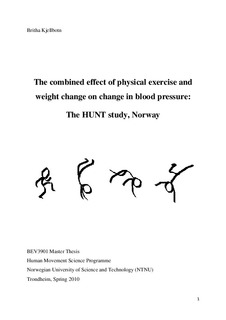| dc.description.abstract | Background: Both weight change and physical activity have been shown to be individual factors that affect blood pressure, but the combined effect of physical activity and weight change is still debated.
Objectives: To investigate the effects of physical activity and weight change on long term changes in both systolic-and diastolic blood pressure.
Design: A population- based longitudinal study, using baseline data from 1984-1986 and follow-up information in 1995-1997.
Setting: The Nord-Trøndelag Health Study (HUNT).
Subjects: We included 39 312 Norwegian subjects (18 727 men and 20 585 women) who were 20 year or older in the first survey, who were without blood pressure medication, diabetes, cardiovascular disease or movement dysfunction, and who had sufficient data on weight, height, physical activity, blood pressure or any other variable required in this analysis.
Measurements: Height, weight and blood pressure were measured using standardized procedures at both surveys. We classified weight change into the following categories; ≤-5.0, -4.9 to -2.1, ±2.0 (stable), 2.1-4.9, 5.0-9.9, 10.0-14.9, 15.0-19.9, and ≥20.0 kg. Physical activity was measured as frequency, intensity, and duration, and we also constructed a summary score by combining information on the three factors. Based on the summary score, we constructed a variable with five categories that reflects the total exercise volume: No activity, <1 exercise per week, low score, medium score, and high score.
Results: An increase in weight and a decrease in weight were significantly associated with increased and decrease in both systolic- and diastolic blood pressure in both sexes. Men with the highest decrease in weight, had a systolic blood pressure change that were 6.83 mmHg (95% CI, -8.01 to -5.66) lower than the reference group with stable weight, whereas men with the highest weight gain had a change that was 6.12 mmHg (95% CI, 4.09 to 8.15) higher. The corresponding data for women were 6.39 mmHg (95% CI,-7.53 to -5.26) lower, and 8.34 mmHg (95% CI, 6.79 to 9.90) higher than the reference group. No significant association between physical exercise and blood pressure was found. In the combined analysis weight change was the most pronounced factor, with little or no contribution from physical exercise.
Conclusion: Our results support the independent effect of weight change on change in systolic-and diastolic blood pressure. Weight change was the strongest predictor for change in blood pressure in the combined analyses, whereas little or no association between physical exercise and blood pressure were found. | nb_NO |
